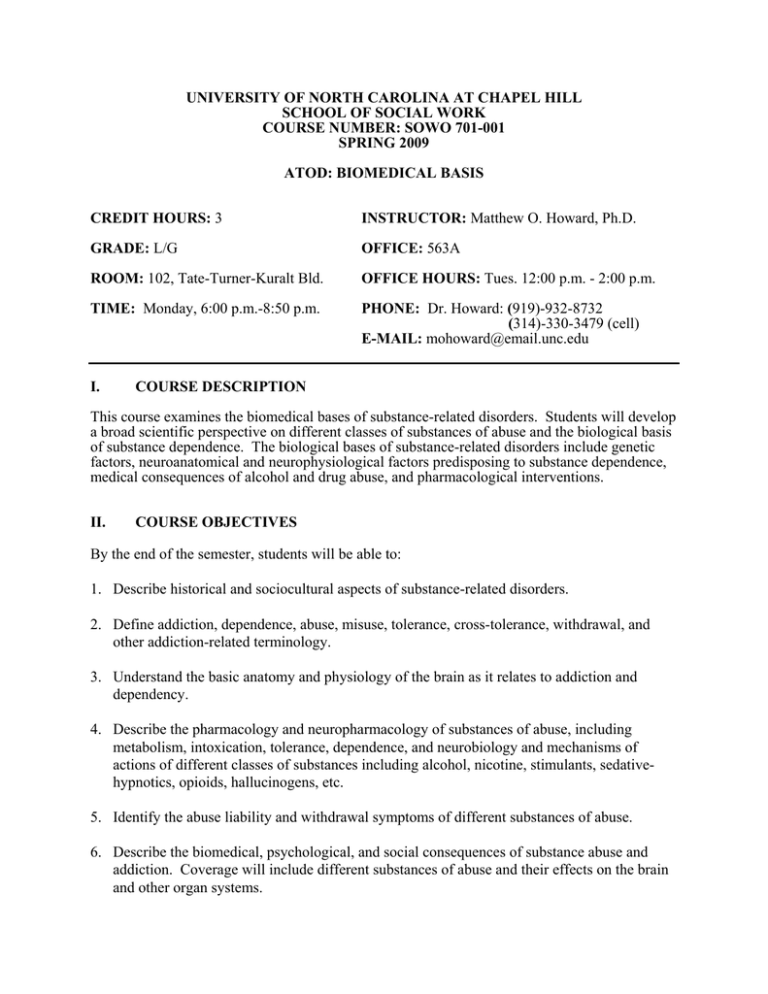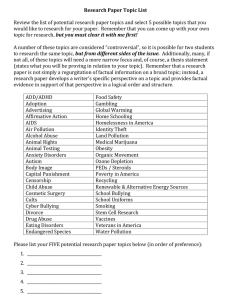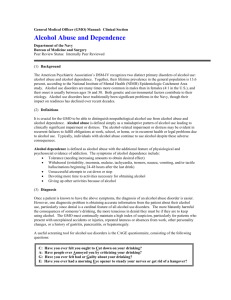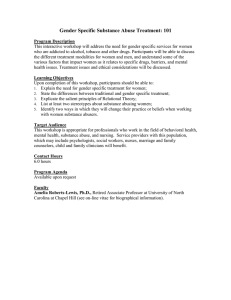UNIVERSITY OF NORTH CAROLINA AT CHAPEL HILL SCHOOL OF SOCIAL WORK
advertisement

UNIVERSITY OF NORTH CAROLINA AT CHAPEL HILL SCHOOL OF SOCIAL WORK COURSE NUMBER: SOWO 701-001 SPRING 2009 ATOD: BIOMEDICAL BASIS CREDIT HOURS: 3 INSTRUCTOR: Matthew O. Howard, Ph.D. GRADE: L/G OFFICE: 563A ROOM: 102, Tate-Turner-Kuralt Bld. OFFICE HOURS: Tues. 12:00 p.m. - 2:00 p.m. TIME: Monday, 6:00 p.m.-8:50 p.m. PHONE: Dr. Howard: (919)-932-8732 (314)-330-3479 (cell) E-MAIL: mohoward@email.unc.edu I. COURSE DESCRIPTION This course examines the biomedical bases of substance-related disorders. Students will develop a broad scientific perspective on different classes of substances of abuse and the biological basis of substance dependence. The biological bases of substance-related disorders include genetic factors, neuroanatomical and neurophysiological factors predisposing to substance dependence, medical consequences of alcohol and drug abuse, and pharmacological interventions. II. COURSE OBJECTIVES By the end of the semester, students will be able to: 1. Describe historical and sociocultural aspects of substance-related disorders. 2. Define addiction, dependence, abuse, misuse, tolerance, cross-tolerance, withdrawal, and other addiction-related terminology. 3. Understand the basic anatomy and physiology of the brain as it relates to addiction and dependency. 4. Describe the pharmacology and neuropharmacology of substances of abuse, including metabolism, intoxication, tolerance, dependence, and neurobiology and mechanisms of actions of different classes of substances including alcohol, nicotine, stimulants, sedativehypnotics, opioids, hallucinogens, etc. 5. Identify the abuse liability and withdrawal symptoms of different substances of abuse. 6. Describe the biomedical, psychological, and social consequences of substance abuse and addiction. Coverage will include different substances of abuse and their effects on the brain and other organ systems. 7. Understand the epidemiology of substance abuse, including the prevalence and consequences of substance abuse in special populations including women, the elderly, adolescents, Native Americans, African Americans, other ethnic minority groups, the aged, gay, lesbian, bisexual and transgendered persons, and health professionals. 8. Describe existing models and conceptualizations of substance use, abuse, and dependence, including genetic, biological, biopsychosocial, and public health models of dependence and its consequences. 9. Discuss the attributes and effectiveness of current approaches to the primary, secondary, and tertiary prevention of substance use disorders. III. SECONDARY COURSE OBJECTIVES Secondary objectives of the course will be to: 1. Examine important genetic, psychological, neuropsychological, temperamental, psychiatric family, cultural, and socioeconomic factors in the etiology of substance abuse and dependence. 2. Provide students with a detailed account of the social, economic, and personal (i.e., biomedical and psychological) costs of alcohol and drug use. 3. Provide students with the skills they need to conduct comprehensive substance use assessments, assign diagnoses consistent with DSM-IV and other nosological systems, and the skills necessary to select and apply leading evidence-based interventions. 4. Introduce students to the full range of pharmacological treatments for substance abuse, including anticraving agents such as naltrexone and acamprosate, rapid opioid detoxification, benzodiazepine and opioid overdose reversal, and opioid antagonist and substitution therapies such as burprenorphine and methadone. 5. Introduce students to the international epidemiology of substance use disorders and national and international policy and legislative measures attempting to reduce the supply of, and demand for, licit and illicit substances. 6. Introduce students to important issues or concerns (e.g., psychiatric comorbidity, polysubstance abuse, special populations considerations) relevant to the success of substance abuse prevention and treatment approaches and policy issues pertinent to social justice considerations. IV. EXPANDED DESCRIPTION: 2 This course is designed as a review of basics as well as an update on new methods and discoveries that bear on the causes and treatment of substance dependence. Although the course will focus on recent scientific findings pertaining to the biomedical bases of dependence and its treatment, it will be packaged for persons without a significant science background. This course will emphasize biomedical factors as they play a role in the etiology, epidemiology, natural history, expression, adverse consequences, treatment and prevention of diverse substance use disorders. We will study the distinction between drug abuse as a social problem and drug dependency as a brain disease. The course will focus on drugs such as alcohol, cocaine, nicotine, benzodiazepines, opioids, caffeine, marijuana, amphetamines, steroids, etc. Further, fetal and other health consequences of substance abuse and dependence will be explored throughout the course. Whether they work directly in chemical dependency treatment or in general social service settings, most social workers interact regularly with substance-using clients and colleagues. Substance use disorders are ubiquitous within the United States, in general and clinical populations, and are associated with significant personal, familial, social and economic costs. Disadvantaged groups are especially likely to experience the pernicious consequences of alcohol and drug use, which further complicate their efforts to cope with stressful and discouraging life circumstances. Although substance use disorders are prevalent and disabling, numerous studies suggest that social workers and other health care professionals often fail to identify and intervene with the substance-using clients they serve. As a result, many opportunities to reduce the suffering of these persons and their families are lost. This course is designed to provide social work students with a comprehensive introduction to the epidemiology, etiology, prevention and treatment of alcohol and drug use disorders, with particular attention to neurobiological, medical, genetic, and other biomedical factors that play key roles in the development and continuation of substance dependency and its consequences. The first half of the course will focus primarily on alcohol, tobacco, and behavioral addictions, since these disorders are the most commonly encountered and clinically significant psychoactive substance use problems addressed in clinical settings. Cocaine, marijuana, opioid, hallucinogen, ecstasy, inhalant and other substance use disorders, will be addressed in the second half of the course, with special attention to the role of biomedical factors in these problems. Introductory sessions will examine historical issues pertaining to alcohol and drug use, including significant social policies and legislation, and the prevalence of substance use internationally and within specific subpopulations of the United States. The scope, nature, treatment, and prevention of alcohol and drug use disorders within gay and lesbian, ethnic and racial minority, women, aged, and other diverse groups including those of different cultures, classes, religions and with physical and mental disabilities, will be specifically addressed. Medical and social consequences of alcohol and drug use will then be examined in detail. Definitional and theoretical issues, particularly those associated with the diagnosis and presumed etiology of substance abuse problems, will be the focus of several classroom sessions. Genetic, psychological, and social factors important to the pathogenesis of substance dependence will be identified. Evidence-based approaches to the treatment of alcohol- and drug-use disorders will 3 be a major focus of this course, particularly pharmacological and other biomedically-based treatment methods. Promising approaches to the prevention of substance abuse and policy maneuvers designed to reduce the social costs associated with such abuse are examined. Controversial issues in the addictions will also be briefly addressed. At the conclusion of this course, students will be aware of current issues and treatment approaches in the addictions and may choose to apply this learning in practica or other service settings. Ethical and social justice issues affecting social work practice in the addictions will be examined throughout the course. Professional use of self in addictions treatment will be addressed. Although primarily covered in SOWO 700, we will briefly review use of: (1) numerous alcohol and drug abuse screening and assessment instruments, including the Michigan Alcoholism Screening Test, Drug Abuse Screening Test, ASI, CAGE, AUDIT, and TWEAK, (2) various assessment instruments evaluating mental health conditions commonly occurring in conjunction with substance abuse (e.g., Beck Depression Inventory), (3) treatment plans incorporating evidence-based interventions that are biomedically based, and (4) practice guidelines, treatment manuals, and systematic reviews as evidence-based treatment planning resources. V. EDUCATIONAL OUTCOMES 1. Students will be able to describe the epidemiology of substance use disorders within different U.S. subpopulations, including gay and lesbian, ethnic and racial minority, women, aged, and other diverse groups including those from different cultures and people with physical or mental disabilities or holding different religious views. 2. Students will be able to compare and contrast different conceptuatlizations (e.g., moral, disease, etc.) of substance use disorders vis-a-vis their implications for the prevention and treatment of substance use disorders. 3. Students will be able to describe important genetic, psychological, and socioeconomic factors in the etiology of substance use problems. 4. Students will be able to identify specific social, economic, and personal costs of alcohol and drug use. 5. Students will be able to identify appropriate instruments for, and important considerations in, screening, assessing and diagnosing substance-abusing clients and will be able to apply these approaches in practice. 6. Students will develop the capacities to identify new developments in, and apply evidencebased approaches to, treatment of substance-dependent clients. 7. Students will be able to identify and assess factors (e.g., psychiatric comorbidity, polysubstance abuse, membership in oppressed groups, etc.) that may affect the nature and outcome of prevention and treatment approaches. 4 8. Students will be able to describe ethical and social justice considerations as they affect policy measures instituted, and legislation enacted, to reduce the supply of, demand for, and adverse consequences of licit and illicit substance abuse. 9. Students will be able to discuss current evidence-based approaches to the primary, secondary, and tertiary prevention of substance use disorders. 10. Students will be able to address epidemiological, etiological, treatment and prevention considerations vis-à-vis tobacco, marijuana, cocaine, opioid, hallucinogen and other drug related problems. 11. Students will be able to identify and discuss social and economic justice issues that are important in substance abuse treatment and articulate the important role that social workers can and should play in addictions treatment. 12. Students will be able to describe important dimensions of professional use of self in addictions treatment. 13. Students will be able to conduct comprehensive substance use assessments, assign diagnoses consistent with the DSM-IV and other nosological systems, and the skills necessary to select and apply leading evidence-based interventions. VI. REQUIRED TEXTS AND OTHER READINGS 1. Ruiz, P., Strain, E.C., & Langrod, J.G. (2007). The substance abuse handbook. Wolters Philadelphia, PA: Kluwer/Lippincott Williams & Wilkins. This handbook is very recent and contains clinically-relevant material drawn from Substance abuse: A comprehensive textbook, fourth edition (2005), perhaps the most comprehensive contemporary textbook in the addictions. This handbook the only text students must buy. Students will also read the following special governmental reports (which will be distributed in class). 2. National Drug Control Strategy, 2008 Annual Report. Office of National Drug Control Policy. 71 pp. 3. National Drug Threat Assessment, 2008. (October, 2007). National Drug Intelligence Center, U.S. Department of Justice, 75 pp. 4. The Surgeon General’s Call to Action to Prevent and Reduce Underage Drinking, 2007, 95 pp. 5. A large number of readings will be handed out in class including approximately 45 to 65 case readings drawn from the recent scientific and clinical literatures and readings drawn from: 5 Grant, J.E. (2008). Impulse control disorders: A clinician’s guide to understanding and treating behavioral addictions. New York, New York: Norton. The book by Grant is very new and was favorably reviewed upon its release. It contains excellent coverage of recent literature pertaining to the behavioral addictions and is written for clinicians. Additional readings and powerpoint slides shows will be forwarded to students on an on-going basis. VII. Teaching Methods The instructor will lecture on key concepts and substantive content. Students’ active participation in discussions is strongly encouraged. Students are expected to complete required readings prior to the beginning of class. DVDs, videos, guest lectures, and group exercises will also be used to convey course material. Grading and Evaluation 1. Reaction Papers (30 points). Brief reaction papers will be due on class sessions 2, 3, and 4. Each of these three reaction papers will be worth 10 points. On week 2, students should turn in the reaction paper reflecting their reading of the National Drug Control Strategy, 2008 Annual Report. On week 3, students should turn in the reaction paper reflecting their reading of the National Drug Threat Assessment, 2008. On week 4, students should turn in the reaction paper reflecting their reading of the Surgeon General’s Call to Action to Prevent and Reduce Underage Drinking, 2007. Each reaction paper should be 2 to 4 pages long (single or doublespaced, no citations required) and include a summary of the report’s organization and contents and a reaction to the conclusions reached by the report. Essentially, I am looking for evidence that you read the report and carefully considered its contents and conclusions. 2. Book Review (15 points). Each student will prepare a review of the book, Impulse-Control Disorders: A Clinician’s Guide to Understanding and Treating Behavioral Addictions, by Jon E. Grant, published in 2008. The book report is due the 8th week of class should be approximately 3 to 5 pages in length. Students often spend 1 or 2 pages describing the aims, contents, intended audience, and potential utility of the book for clients, family members, or practitioners. They then devote 1 or 2 pages to a stylistic and substantive critique of the book. 3. Notebook of Reading Notations (25 points). As you read the assigned chapters in the Ruiz et al. handbook, keep written or typed notes on the readings so that you end the course with a notebook of notations that you can refer to in the future. Please turn this notebook in during the final class session. You will receive all 25 points for this assignment, if you provide an outline of each chapter reading containing the essential points and include a definition for each important term you encounter. I will not be rigid or excessively stringent in my grading of your notebook, but want to see evidence that you read the material and were able to identify and outline the major concepts and issues contained therein. It can be a good idea to show me your 6 notes early in the semester to check and see that they suffice. Notes do not have to be extensive, but they should contain key concepts and terms in each assigned chapter. 4. Annotated Readings (20 points): Over the course of the semester, I will distribute approximately 70 case studies drawn from the clinical literature detailing various biomedical consequences of alcohol and drug use. You can select from these readings, a total of 40 such reports and will receive ½ point for each case study that you read and turn in for a total of 20 points. This sounds like a lot of reading, but most of the case studies you read will range from only 1 to 3 pages in length. All you have to do is read the report, highlight or underline key concepts or terms as you read, and write an occasional note in the margins of the reading to raise questions or otherwise let me know that you are carefully reading the material. 5. Class participation (10 points): will be a function of class attendance and the intellectual contribution the student makes to the class. All persons who miss 0 or 1 classes will receive 5 points for attendance, students who miss 2 or 3 classes will receive 3 points for attendance, and those who miss more than 3 classes will receive 0 points for attendance. Students who participate regularly and who make a good contribution to class will receive 5 points for their contribution to class, those who contribute occasionally will receive 3 or 4 points for their intellectual contribution depending on the quality of their contribution, and students who contribute rarely, are disengaged from class, or who make comments that indicate they have not completed the relevant assignments, will receive either 0, 1, or 2 points depending on the regularity and pertinence of their contributions. Grading System: 94-100 = H 80-93 = P 70-79 = L 69 and below = F Policy on Late and Incomplete Assignments: Students are expected to turn in all assignments on time. Incomplete or tardy assignments will be discussed with the particular student in question. Policy on Academic Dishonesty: All written assignments should include a signed pledge from you stating that, “I have not given or received unauthorized aid in preparing this written work.” In keeping with the UNC Honor Code, if reason exists to believe that academic dishonesty has occurred, a referral will be made to the Office of the Student Attorney General for investigation and further action as required. Please refer to the APA Publication Manual and School of Social Work Student Manual and Writing Guide for information regarding attribution of quotes, plagiarism, and appropriate use of assistance in preparing classroom assignments. VIII. COURSE OUTLINE Session One: COURSE OVERVIEW AND HISTORICAL AND 7 January 12th EPIDEMIOLOGICAL ISSUES IN ALCOHOL AND DRUG USE, ABUSE, AND DEPENDENCE This session will address basic epidemiological issues and will place alcohol use in its historical and cultural context. Topics: 1. Overview of Course 2. History of Alcohol and Drug Use 3. Epidemiology of Alcohol and Other Drug Use and Social Work Significance of Substance Use Disorders Required Readings: 1. National Drug Control Strategy, 2008 Annual Report 2. Chapter 1, “Determinants of Substance Abuse and Dependence” in Ruiz et al. Assignment: Prepare Reaction Paper #1 and turn in Session Two. Session Two: January 26th DEFINITIONAL, CONCEPTUAL, AND ETIOLOGICAL ISSUES IN THE ADDICTIONS This session will overview various definitional and theoretical issues in the addictions and major etiological models, with particular attention to biomedical models and etiological factors. Topics: Definitions, Conceptions and Theories of Alcohol and Drug Abuse. 1. Etiological factors in the Development of Substance Use Disorders a. Genetic/Biological b. Psychological c. Social/Cultural Required Readings: 1. National Drug Threat Assessment, 2008 2. Chapter 2, “Alcohol,” in Ruiz et al. Assignment: Reaction Paper #2 due Session 3. 8 Session Three: February 2nd THE NEUROBIOLOGY OF ADDICTION 1. Basic Brain Science 2. Brain Structure and Function in Chemical Dependency 3. Genetic Inheritance of Vulnerablity to Addiction Required Readings: 1. The Surgeon General’s Call to Action to Prevent and Reduce Underage Drinking, 2007 Assignment: Reaction Paper #3 due on Session 4. Session Four: February 9th MEDICAL AND SOCIAL CONSEQUENCES OF ALCOHOL ABUSE AND ALCOHOL DEPENDENCE This session comprehensively addresses the social and physical effects of alcohol abuse and alcohol dependence from an individual and societal perspectives. Topics: 1. Medical Complications of Alcohol and Drug Abuse. 2. Social Consequences of Alcohol and Abuse a. Effects on Families, Employment, Crime, etc. Required Readings: 1. Preface, Introduction, and Chapters 1-4 in Jon E. Grant’s, Impulse Control Disorders: A Clinician’s Guide to Understanding and Treating Behavioral Addictions 2. Chapters 34, 35, and 36 in Ruiz et al. Session Five: February 16th MEDICAL AND SOCIAL CONSEQUENCES OF ALCOHOL ABUSE AND DEPENDENCE CONTINUED/BRIEF REVIEW OF ECONOMIC CONSEQUENCES OF ALCOHOL USE PROBLEMS AND SCREENING This session will focus on the terotogenic effects of alcohol and drug abuse, economic costs of alcohol use disorders, and will expose students to a number of useful screening instruments and 9 will conclude the discussion of the biomedical, social, and economic consequences of alcohol abuse and alcoholism. Topics: 1. Fetal alcohol effects of alcohol and drug use and abuse 2. Economic Costs of Alcohol Abuse and other Economic Issues. a. Alcohol-Related Trauma; Air, Motor Vehicle and Water Safety, High-Risk Sexual Behavior, and Violence. b. Economic Costs of Alcohol Abuse and Treatment of Alcohol Use Disorders. c. Social and Economic Justice Concerns Related to Alcoholism 3. Screening and Assessment of Alcohol Problems Required Readings: 1. Chapters 5-7 in Jon E. Grant’s, Impulse Control Disorders: A Clinician’s Guide to Understanding and Treating Behavioral Addictions 2. Chapters 37 and 38 in Ruiz et al. Session Six: February 23rd TREATMENT CONSIDERATIONS AND SPECIAL POPULATIONS Tailoring treatment to special client groups will be the focus of this session. Topics: Treatment of Alcohol Abuse and Dependence: What Works in Alcoholism Treatment? Motivating Clients to Change and Assessing Readiness to Change. Matching Clients to Treatment. a. Overview i. Settings (inpatient/outpatient, etc.) ii. Format (individual/group/family) iii. Modalities (Antidipsotropic and Anti-craving Therapies) b. Special Populations Considerations Required Readings: 10 1. Chapters 8-10 in Jon E. Grant’s, Impulse Control Disorders: A Clinician’s Guide to Understanding and Treating Behavioral Addictions 2. Chapters 15, 16, and 17 in Ruiz et al. Session Seven: March 2nd DEVELOPMENTAL PSYCHOPATHOLOGY OF ADDICTION AND COMORBID SUBSTANCE USE AND PSYCHIATRIC DISORERS: BIOMEDICAL FACTORS AND THEIR INTERPLAY WITH SOCIAL FACTORS Required Reading: 1. Chapters 18, 19, 39, 40, 41, in Ruiz et al. Session Eight: March 16th MARIJUANA ABUSE AND DEPENDENCE/MIDTERM Topics: Marijuana Abuse and Dependence a. Epidemiology b. Etiology c. Consequences d. Assessment/Treatment Required Readings: 1. Chapter 5 in Ruiz et al. Assignment Due: Book Review of Jon E. Grant’s, Impulse Control Disorders: A Clinician’s Guide to Understanding and Treating Behavioral Addictions Session Nine: March 23rd STIMULANTS Topics: 1. Stimulants: Cocaine, Amphetamines, Caffeine, Nicotine and Other Drugs a. b. c. Cocaine Amphetamines Caffeine 11 d. e. Nicotine Other i. Khat ii. Betel Nuts iii. Yohimbe iv. Ephedra Required Readings: 1. Chapters 4, 6, 12, and 13 in Ruiz et al. Session Ten: March 30th OPIOIDS, SEDATIVES, AXIOLYTICS, AND INHALANTS Topics: 1. Opiods 2. Sedative – Hypnotics 3. Anxiolytics 4. Inhalants Required readings: 1. Chapters 3, 7, 10, 20, 21, and 22 in Ruiz et al. Session Eleven: April 6th OTHER DRUGS OF ABUSE Topics: 1. Hallucinogens 2. Over-the Counter Medications 3. Steroids 4. Controversial Issues: Legalization, Drug Testing, etc. 5. Methods of Treating Drug Dependence Required Readings: 1. Chapters 8, 9, 11, and 14 in Ruiz et al. Session 12 CONTROVERSIAL ISSUES AND ETHICAL AND SOCIAL 12 April 13th JUSTICE CONCERNS IN THE ADDICTIONS/INTRODUCTION TO PHARMACOLOGY Topics: 1. Controversial Issues in the Alcohol Studies and Treatment Areas a. Controlled Drinking by Alcoholics vs. Abstinence-Only Treatment Goals b. Consequences of the War on Drugs c. The Effectiveness of Alcoholics Anonymous d. Denial and Motivation in Alcoholism Treatment e. Co-Dependency and Adult Children of Alcoholics f. The Validity of Alcoholics’ Self-Reports 2. Review of General Considerations in Alcohol and Drug Abuse a. Routes of Administration b. Dosage Forms c. Pharmokinetics d. Metabolism e. Factors that influence drug metabolism: i. Age ii. Circadian Rhythms iii. Drug Interactions iv. Purity and Potency v. Set and Setting vi. Tolerance f. The neurochemistry of addiction i. Neurotransmitter systems ii. Neuroanatomical considerations Required Readings: 1. Chapters 23, 24, and 25 in Ruiz et al. Session Thirteen: April 25th Comprehensive Review of Course Topics/Future Directions Required Readings: Chapters 26, 27, 28, 29 in Ruiz et al. Session Fourteen: April 27th Turn in Notes on Readings 13 Required Readings: Chapters 30, 31, 32, 33, 44, and 46 in Ruiz et al. 14





